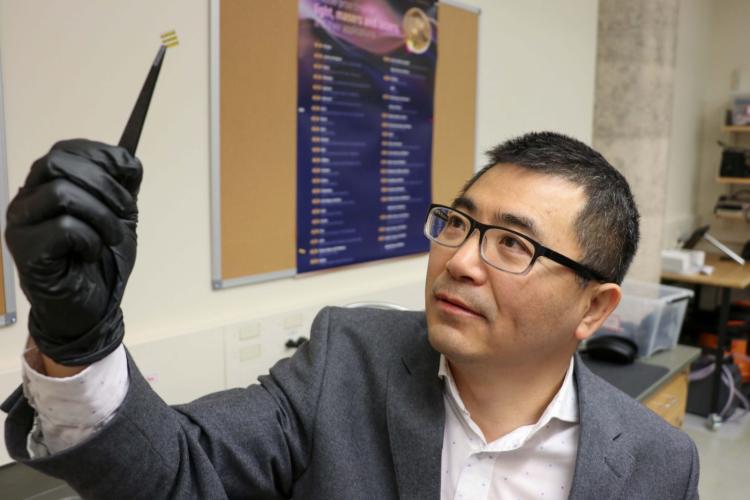A Brock University quantum physics research team is laying the groundwork for next-generation innovations in a wide range of products.
"Quantum" refers to the smallest unit photons, electrons, atoms or molecules that make up a physical substance.
In his latest project, Associate Professor of Chemistry Jianbo Gao is studying advanced nanostructured materials, which are made of components such as gold, semiconductors and crystals the size of a nanometer, which is a billionth of a metre. By comparison, a human hair is around 60,000 to 100,000 nanometres thick.
At this minuscule size, materials have different properties than they do when they are larger, expanding scientists' understanding of physics properties, Gao says.
"With this fundamental science research, we can develop many different novel technologies and answer unknown questions in the fundamental fields of photophysics, physical chemistry and electrical engineering, then translated into the fields of quantum technology and generative artificial intelligence," he says.

Associate Professor of Chemistry Jianbo Gao and his team are creating photosensing devices, or small chips, to boost the performance of fiber optic cables, autonomous driving systems and graphics processing units used in generative artificial intelligence.
Building on his pioneering research on introducing quantum dots into solar cells, Gao and his team are developing devices that can be integrated into fibre optic cables, autonomous driving systems and graphics processing units used in generative artificial intelligence (AI).
Their work is focused on human-made nanocrystal semi-conductors called quantum dots.
Quantum dots create a type of light in next-generation single photon emitters, equipment used in quantum communications, computers and other technologies.
Gao and his team are now creating photosensing devices, or small chips, based on nanostructured materials that can perceive light beyond the range of human vision. The researchers are using a state-of-the-art ultrafast laser to create those novel devices.
"These extremely sensitive, fast response devices can detect extremely weak light even in complete darkness, capture fast dynamics occurring in less than a trillionth of a second, and achieve remarkably high detection efficiency," says Gao.
Integrating these small chips into optical quantum communication fibres facilitates secure, reliable, light-speed transmission of communication over long distances, says Gao.
He says this could boost security and performance for global technology companies that have their own fibre optic cable networks.
The small chips could also enable self-driving cars to see clearly and faster at night, "spotting people, obstacles, buildings, surrounding environment that normal cameras can't, making nighttime driving safer and more reliable," says Gao.
In the area of generative AI, the chips could help produce images that are invisible to the human eye -- in the infrared wavelengths -- so that in-depth and comprehensive medical imaging can be achieved.
The project is supported by an Idea to Innovation (I2I) grant from the Natural Sciences and Engineering Research Council of Canada (NSERC), which is funded by the Government of Canada.
"Dr. Gao and his team are on the cutting edge of quantum technologies that have the potential to revolutionize the speed and efficiency we've come to rely on as a society," says Brock Vice-President Research Tim Kenyon. "This prestigious, competitive award indicates the promise that Dr. Gao's research shows in his field."
NSERC's Idea to Innovation (I2I) grants support university and college researchers to develop promising technologies and transfer these to new or established Canadian companies.
"Science and technology innovation drive sustainable economic growth," says St. Catharines Member of Parliament Chris Bittle. "Industries will apply the benefits of Dr. Gao's exciting invention, a partnership personifying the Canadian government's commitment to the betterment of society."
Included on Gao's team is Brock LINC Innovation and Commercialization Manager Noshin Hashim. She will be leading efforts to commercialize Gao's devices through intellectual property management, market positioning and industry outreach.
"The I2I funding supports Dr. Gao's transition from discovery research to prototype development and industry validation, advancing Brock University's applied research momentum," says Brock LINC Executive Director of Innovation, Commercialization and Entrepreneurship Farzana Crocco.













